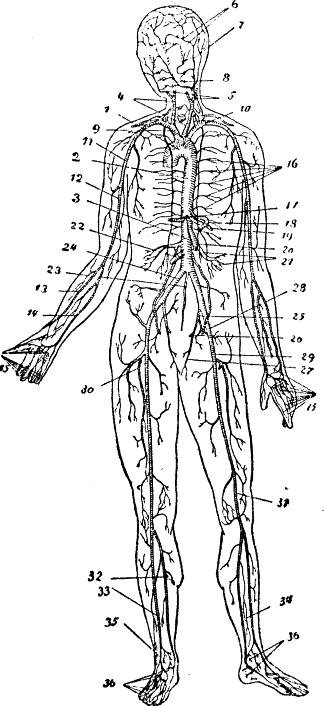Blood vessel
|
|
The blood vessels are part of the circulatory system and function to transport blood throughout the body. The most important types, arteries and veins, are so termed because they carry blood away from or towards the heart, respectively.
| Contents |
Types
Blood vessels exist in varying calibers:
- Arteries
- Aorta (the largest artery, carries blood out of the heart)
- Branches of the aorta, such as the carotid artery, the subclavian artery, the celiac trunk, the mesenteric arteries, the renal artery and the ileac artery.
- Arterioles
- Capillaries (the smallest blood vessels)
- Venules
- Veins
- Large collecting vessels, such as the subclavian vein, the jugular vein, the renal vein and the iliac vein.
- Venae cavae (the 2 largest veins, carry blood into the heart)
They are roughly grouped as arterial and venous, determined by whether the blood in it is flowing toward or away from the heart. The term "arterial blood" is nevertheless used to indicate blood high in oxygen, although the pulmonary artery carries "venous blood" and blood flowing in the pulmonary vein is rich in oxygen.
Anatomy
All blood vessels follow the same histological makeup. The inner lining is the endothelium, followed by subendothelial connective tissue. Then follows a muscular layer of vascular smooth muscle, which is highly developed in arteries. Finally, there is a further layer of connective tissue termed the adventitia, which contains nerves that supply the muscular layer, as well as nutrient capillaries in the larger blood vessel.
Capillaries consist of little more than a layer of endothelium and occasional connective tissue.
Physiology
Blood vessels do not actively engage in the transport of the blood (it has no appreciable peristalsis), but arteries - and veins to a degree - can regulate their caliber by contraction of the muscular layer. This determines the blood flow to particular downstream organs, and is determined by the autonomic nervous system. Vasodilation and vasoconstriction are also used antagonistically as a method of thermoregulation in homeotherms.
Oxygen (bound to hemoglobin in red blood cells) is the most critical nutrient carried by the blood. In all arteries apart from the pulmonary artery, hemoglobin is highly saturated (95-100%) with oxygen. In all veins apart from the pulmonary vein, the hemoglobin is desaturated at about 70%. (The values are reversed in the pulmonary circulation.)
The blood pressure in blood vessels is traditionally expressed in millimetres of mercury (1 mmHg = 133 Pa). In the arterial system, this is usually around 120 mmHg systolic (high pressure wave due to contraction of the heart) and 80 mmHg diastolic (low pressure wave). In contrast, pressures in the venous system are constant and rarely exceed 10 mmHg.
Vasoconstriction is the constriction of blood vessels (narrowing, becoming smaller in cross-sectional area) by contracting the vascular smooth muscle in the vessel walls. It is regulated by vasoconstrictors (agents that cause vasoconstriction). These include paracrine factors (e.g. prostaglandins), a number of hormones (e.g. vasopressin and angiotensin) and neurotransmitters (e.g. adrenalin) from the nervous system.
Vasodilation is a similar process mediated by antagonistically acting mediators. The most prominent vasodilator is nitric oxide (termed endothelium-derived relaxing factor for this reason).
Permeability of the endothelium is pivotal in the release of nutrients to the tissue. It is also increased in inflammation in response to histamine, prostaglandins and interleukins, which leads to most of the symptoms of inflammation (swelling, redness and warmth).
Role in disease
Blood vessels play a role in virtually every medical condition. Cancer, for example, cannot progress if the tumor does not cause angiogenesis (formation of new blood vessels) to supply the malignant cells' metabolic demand. Atherosclerosis, the formation of lipid lumps (atheromas) in the blood vessel wall, is the prime cause of cardiovascular disease, the main cause of death in the Western world.
Blood vessel permeability is increased in inflammation. Damage, due to trauma or spontaneously, may lead to hemorrhage. In contrast, occlusion of the blood vessel (e.g. by a ruptured atherosclerotic plaque, by an embolised blood clot or a foreign body) leads to downstream ischemia (insufficient blood supply) and necrosis (tissue breakdown).
Vasculitis is inflammation of the vessel wall, due to autoimmune disease or infection.
See also
| Cardiovascular system |
| Heart - Aorta - Arteries - Arterioles - Capillaries - Venules - Veins - Venae cavae - Pulmonary arteries - Lungs - Pulmonary veins - Blood |
es:vaso sanguíneo ja:血管 lt:Kraujagyslė nl:bloedvat pt:Vaso sanguíneo fi:Verisuoni

